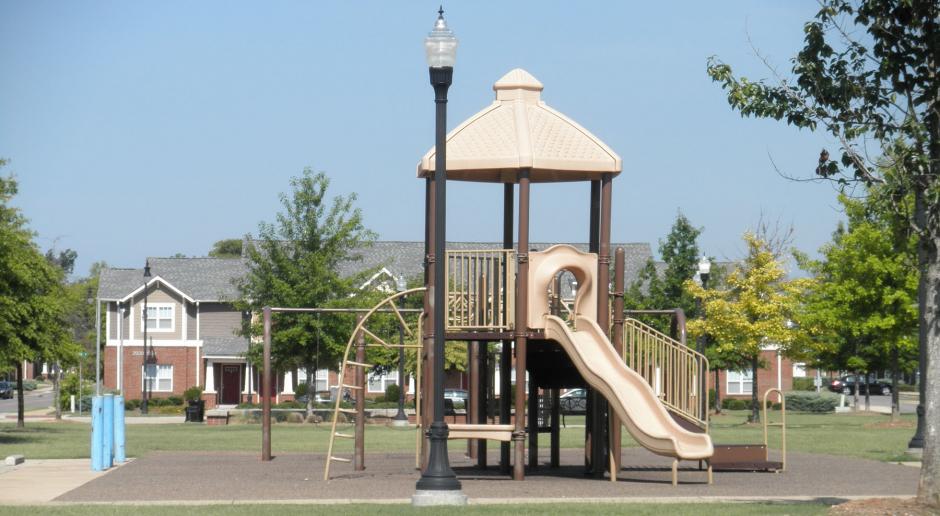PROVIDENCE, R.I. [Brown University] — When the HOPE VI community revitalization project in the disadvantaged Birmingham, Ala., neighborhood of Ensley reached the phase of building walking and biking paths, green spaces, and improved lighting in 2010, two things happened, according to a new study: First, residents developed specific expectations that leisure exercise would become more plausible, and then they followed through and got out there.
Before the neighborhood’s revitalization, launched in 2006 with funding from the federal program Housing Opportunities for People Everywhere and other sources, the area was one where going out for a jog or a bike ride was an uninviting if not daunting prospect.
“The community was a very high-crime area and definitely a food desert,” said Akilah Dulin-Keita, assistant professor of behavioral and social sciences in the Brown University School of Public Health and lead author of the study in August issue of the journal Social Science & Medicine. “It was unsafe. It was a high-needs community.”

“We really thought it was important to represent [residents’] voices in the study and their insights about how they would be influenced.”
Dulin-Keita, then a health researcher at the University of Alabama–Birmingham, not only wanted to measure whether the revitalizations of HOPE VI resulted in residents opting to exercise more but also to elicit and understand the views of the residents that might underlie their response to the project, which had replaced the blighted “Brickyard” housing complex with a new one, Tuxedo Terrace. So before she conducted the statistical survey that confirmed an increase in exercise after revitalization, she led an effort to engage community organizations and residents in documenting and analyzing community perceptions and expectations about the project.
“We really thought it was important to represent their voices in the study and their insights about how they would be influenced,” said Dulin-Keita, who teaches a class on urban design and health called “Place Matters.” “Being able to ask how they felt and what they expected and then being able to test those things quantitatively can provide insight into why [an intervention] is working.”
High hopes and tough realities
In several group discussion sessions at community libraries, Dulin-Keita and her colleagues elicited more than 50 residents’ thoughts on the question “How do you think the new Tuxedo housing will affect participation in physical activity?”
In the aggregate of analysis, the statements clustered under a few topics: expectations of increased physical activity (e.g., “there will be a ripple effect because if you see one person out, this will have a positive effect on motivating other people’s physical activity”), safe areas to play (e.g., “the new HOPE VI development is well lit, you can go walk and see what is in front/behind you”), and health-promoting resources (e.g., “with the proposed items such as swimming pools, walking tracks, and bike trails, people will become more physically active”).
But Dulin-Keita said many of the resident’s statements made it clear how difficult the environment was for discretionary, or “leisure,” exercise before the change. One resident noted that it would be safe for their kids to play if there were no more broken glass, syringes, or needles, Dulin-Keita recalled. Another resident said, “If you were afraid to go in the Brickyard, now you won’t be.” She recalled another resident saying, “With the removal of the shrubbery, now you don’t have to worry about who’s waiting behind the bushes to rob you.”
The study quotes another resident who pointed out that increased exercise might not be safer if authorities don’t understand the change afoot: “Police should be aware that the physical activity is increasing in the neighborhood so that black males jogging won’t be profiled.”
Down to the data
The statements informed the design of Dulin-Keita’s quantitative survey, conducted with 120 people both before the walking and biking trails were built and again six months later, after they were in place. There, she asked about changes in perception of the neighborhood and whether or not people said they were engaging in more leisure physical activity.
In different versions of the statistical analysis, residents’ senses of improved neighborhood walkability and of personal physical safety were associated with increases in physical activity at the six-month followup. A sense of improvement in “neighborhood disorder” (less graffiti, fewer abandoned buildings, and less general crime), however, did not predict increased physical activity.
Although Dulin-Keita moved from Alabama to Rhode Island in 2012, she said she would still like to continue working in Ensley to track whether community norms related to exercise have changed and to make more precise measurements of physical activity, replacing self-reports with wearable accelerometers.
In addition to Dulin-Keita, other authors on the study are Olivio Clay, Shannon Whittaker, Lonnie Hannon, Ingrid Adams, Michelle Rogers, and Kim Gans.
The Centers for Disease Control and Prevention (1-U48-DP-001915) and the National Institutes of Health (T32DK062710, R00-DK83333) funded the research.

